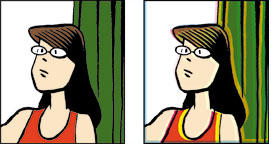Most books with color art are printed in CMYK, whose letters stand for cyan, magenta, yellow and black (I believe the "K" actually stands for "key color"--which is always black). When printed in various intensities, those four inks can make most (but not all) other colors. For example, equal amounts of yellow and magenta make red. Cyan plus yellow is green, magenta plus cyan is purple, etc.


"Trapping" is an obscure but interesting part of the pre-press process. In CMYK printing each color of ink is printed separately, one after the other, so that a page actually goes through the press four times. If the paper lines up perfectly with each pass, all the colors align and you get perfect registration. Very often, though, if you look at four-color printing closely enough, you can see that the inks are just a bit off. You'll see a colored halo on one side, or colors slopping out of their black boundaries, or a gap where colors don't meet up.
 Good registration (left) and bad (right)
Good registration (left) and bad (right)
That discussion came in handy when I got word late last week that the printer wasn't happy with my color registration. It wasn't coming out right. Not lining up. Within half a second I realized the problem: no trapping. When I submitted my final image files to Abrams they were trapless. Trap-free. Bereft of trap. My trapping had shuffled off this mortal coil, run down the curtain, and joined the choir invisible. The subject never came up and I never thought to ask. My bad.
So I spent a few hours this morning speedily trapping the 26 color pages scattered throughout Mom's Cancer. I envisioned the overseas printer tapping his toe, glancing nervously at his watch, paying overtime while the presses waited in idle silence for my upload.
Assuming my trapping worked, I should have first proofs to review in a few days. Next book, I'm hiring a high school kid to take care of this.
***
Me back in the present again (old and cynical). I learned a lot from my mistakes on Mom's Cancer, which might have made me a little cocky going into WHTTWOT. What I've realized, of course, is that now I have whole new opportunities to make entirely different mistakes. Despite my threat above, I did not hire any high school kids to do my trapping this time. However, I did hire some college kids to--but that's a subject for a future post.
.
Useful article on CMYK and trapping. Thank you!
ReplyDelete